
I stood in a wooded grove beneath the New Jersey Brigade Monument at Gettysburg, a forty-foot-high watchtower that honors the five (1st, 2nd, 3rd, 4th and 15th) regiments of one of the few brigades in the Union army made up entirely of regiments from the same state. It was the most imposing memorial along a custom tour that my nephew, Joey, had booked for our family group with Eric Lindblade, a Licensed Battlefield Guide, last November. Mounted on the tower’s stone perimeter are bas-reliefs of Brig. Gen. Alfred T. A. Torbert, the brigade’s commander at Gettysburg, and General Philip Kearny, the brigade’s inspirational original commander who was widely admired for his courageous leadership and who was tragically killed at the Battle of Chantilly in 1862. The two-hour excursion included sites throughout the battlefield that commemorated the four thousand New Jersey troops that fought there in July, 1863. Although we did not stop at them all, there are also monuments for the First New Jersey Volunteer Calvary, New Jersey Batteries A and B, and for each of the 1st, 4th, 5th, 6th, 7th, 8th, 11th, 12th , and 13th volunteer infantry regiments at Gettysburg. All of the monuments were dedicated on the twenty-fifth anniversary of the eve of the battle, June 30, 1888.
Each of the 1,328 monuments at Gettysburg National Military Park tells a story. But few are as tragic as the one told by the nine-foot-tall granite tribute to the 11th New Jersey Volunteers which brought 275 men into battle on July 2. More than half of those soldiers were killed or wounded when the regiment was caught in a crossfire near the infamous Peach Orchard. Among the casualties were Major Philip John Kearny — the deceased General’s nephew, who later succumbed to his wounds — and the regiment’s commander, Colonel Robert McAllister.
Each time he visits Gettysburg, Joey loads up on books he finds in the stores along Steinwehr Avenue. This time he found one for me called New Jerseyans in the Civil War (by William Jackson, Rutgers University Press), an account in which Robert McAllister and the volume of over nine hundred of his collected letters plays a large part. Nearly every day of his service, the quietly efficient officer found time to write home his family to not only express his faith and affection, but to document the progression of the conflict in which he was occupied: all but two of the engagements of the Army of the Potomac.
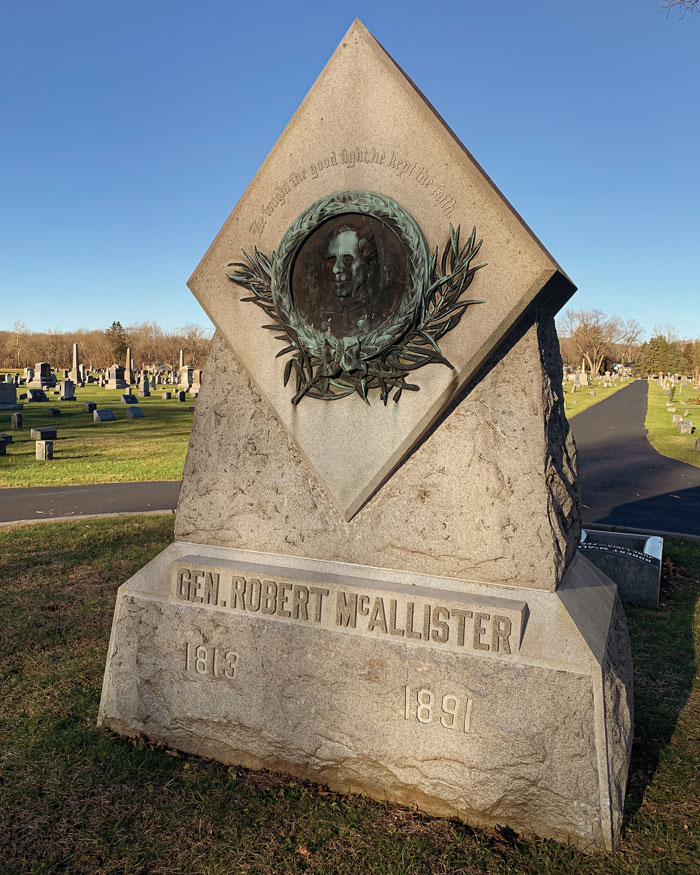
I was aware of McAllister’s impressive grave site in the Belvidere Cemetery — it’s hard to miss — but knew little else about him. When war broke out, McAllister was forty-eight-years-old and living with his family in Oxford, his engineering firm having contracted for the construction of the Van Nest Gap tunnel on the Warren Railroad. When the tunnel was completed in 1862, McAllister was not present for its dedication, having recruited and organized the Warren Guard infantry company and marched to Trenton to await the call to duty. In May, 1861, the Warren Guard became part of the First New Jersey Volunteer Infantry Regiment, and with McAllister as lieutenant colonel traveled to Washington to join the Army of the Potomac. After seeing action during the Union’s Peninsular Campaign through Virginia and assuming command at the Battle of Gaines Mill, McAllister received a long-awaited promotion and returned to Trenton to take charge of the newly formed 11th New Jersey, “McAllister’s Boys”. The colonel’s strict discipline and demand for temperance among his fledgling troops developed a well-trained and much-admired fighting force with engagements against Lee’s Confederates at Fredericksburg, through the Wilderness to Chancellorsville, then on to Gettysburg.
Surgeons had to surreptitiously spike his milk with alcohol in order to ease McAllister’s pain when repairing his wounds at Gettysburg, after which the colonel found his way back to Belvidere for three months of recuperation where he wrote in his notes on the Gettysburg campaign:
“At that moment a Minie ball pierced through my left thigh and a piece of spent shell hit my right foot. I was carried to the rear, supposedly mortally wounded. About the time I fell and was carried back, Maj. Kearny, on whom the command of the regiment would have devolved, fell mortally wounded and was taken back. For five days we lay side by side in my tent on the field. We were then carried on stretchers to Philadelphia, where we parted, never to meet again on earth. He was taken to New York and I to my home in New Jersey. Maj. Kearny was a brave young officer. He loved the service. He would push into the thickest of the fight, his brave example stimulating the men to follow him. No duty was too arduous for him, no danger too great.” (McAllister’s notes on the Gettysburg campaign from The McAllister Letters, Rutgers University Press)
After his convalescence, McAllister returned to his unit and was given command of his brigade, which he never relinquished. McAllister received commendations for his leadership in the subsequent Battles of the Wilderness, Spotsylvania and in the trenches at Petersburg where he earned the brevet of Brigadier General, US Volunteers. When the war came to its conclusion, Colonel McAllister was present at Appomattox. He received another brevet promotion, this time to Major General, US Volunteers, on March 25, 1865 in recognition of his four years of service.
McAllister returned to civilian life, eschewing a postwar military or political career in favor of work for a railroad based in Allentown, PA, commuting to Belvidere on weekends to be with his family. In 1882, Robert and his wife Ellen accepted an invitation to retire to Erlenbach, a Belvidere estate. When he suffered a stroke in 1888, McAllister finally consented to apply for a Federal pension, which was in large part denied. He died in February, 1891, and was buried in a coffin draped with the war-torn flag of New Jersey’s 2nd Brigade. The citizens of Belvidere purchased and commissioned the monument that we see today at McAllister’s grave, dedicated on May 30, 1894. But it was not until the entirety of his letters was published on the occasion of the Civil War Centennial in 1965 that the nobility of “New Jersey’s Forgotten General” approached deserved recognition.
In 1910, the Boonton Business Men’s Association published a booklet entitled Boonton, The Gem of the Mountains. Its seventy-two pages were interspersed with photos of the town’s scenic locations and stately buildings, advertisements for local businesses and a series of short articles about Boonton’s history, churches, schools, social clubs, commerce and industry. There was also a story written by a Boonton harness-maker that narrated his experiences as a boy in 1856 when he helped his father, “a very strong anti-slavery advocate”, in the conduct of slaves on the road to Canada after escape from bondage in the South. “The nearest station to Boonton was the Hotel at Powerville,” he wrote. “There were stations at Rockaway, Dover, Pompton Plains, Newfoundland, Canisteer, Stockholm, and Charlottenburg, all known to the writer, but his experience was in the main confined to Boonton, Stockholm, and Canisteer.
“My orders from father were: Keep your eyes open, ears also, and never spare horseflesh, take all chances yourself, but save your charge from recapture at all hazards. This, to a fourteen-year-old boy, was rather stiff orders, but being young and a strong enthusiast in the cause, and not knowing the possible risk and results, I comforted my mind with the idea that the worst possible thing to happen was failure to save a recapture, as that would have been mortifying in the extreme, both to my parent and my own ambition to succeed.”
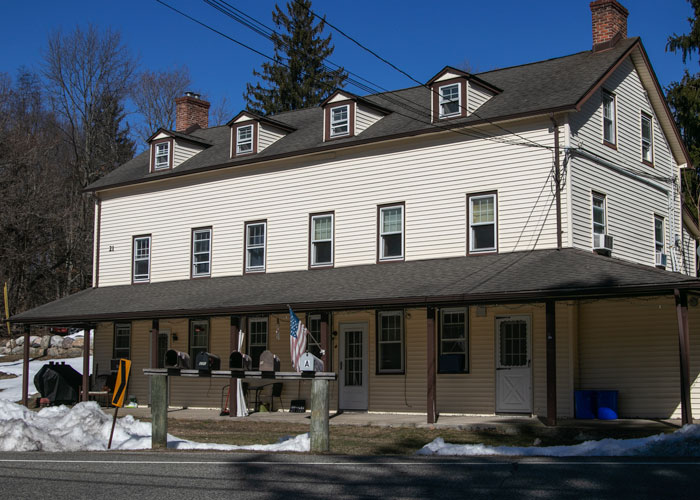
The writer was Charles Fern Hopkins, who was born in Hope (1842) and spent his childhood there and in Drakesville (now Ledgewood). When his mother passed away in 1855, the family moved to Boonton, where in addition to his activities conducting the Underground Railroad, Charles learned his father’s harness-making trade, establishing his own business by the age of eighteen. Underage for the army, Hopkins left home to become the first man from Morris County to join the army, enlisting as a private with Company I of the 1st New Jersey Volunteer Infantry. He followed the regiment to Gaines Mill (under McAllister’s command) where, after heroic action for which he would later be awarded the Congressional Medal of Honor, he was shot in the head and left for dead on the Virginia battlefield. Hopkins survived a long recovery and returned to combat only to be captured in 1864 and sent to the notorious Andersonville prison camp in Georgia. He kept a journal of the inhumane treatment and unspeakable hardships endured by the POWs there.
“The mental anguish of those days and months was the slowest torture to him who’s still at a clear brain — a cruelty to which the barbarian was a stranger. These were the hours that tried the mental strength of the “man,” and were a hundred times worse than the thoughts of a hundred Gettysburg or Chickamauga battles! One was to die in glory under the folds of that flag which he was sworn to defend, and be among his comrades, dying at the post of duty. The other was to rot in misery and degradation among blood of our blood, kin both by blood and Country yet they had forgotten all the ages had praised them for chivalry and civilization.” (The Andersonville Diary and Memoirs of Charles Hopkins, Belle Grove Publishing Company, 1988)
Hopkins survived an inconceivable Hell and was finally discharged as a paroled prisoner in April, 1865. He was twenty-three years old. After a year of convalescence, he resumed a vigorous civic life in Boonton, where, as noted at the town’s Historic Museum, “he set up a harness making business a trade he had learned from his father many years before. He married, raised a family of nine and for the next thirty years became actively involved in public and political affairs. He served as town committeeman, member of the board of freeholders, mayor, New Jersey State senator, postmaster of Boonton, member of the New Jersey assembly, and chief of the Boonton Fire Department. After a full and productive life, he died in 1934 at the age of ninety-two.”
Hopkins persisted in his support for veterans and headed the commission to erect a monument at Andersonville for the 235 New Jersey men that died there. And for Philip Kearny, the brigade general that so captivated him as a young recruit, Hopkins was largely responsible for his re-interment at Arlington National Cemetery in 1912 and for the magnificent equestrian statue in his honor.
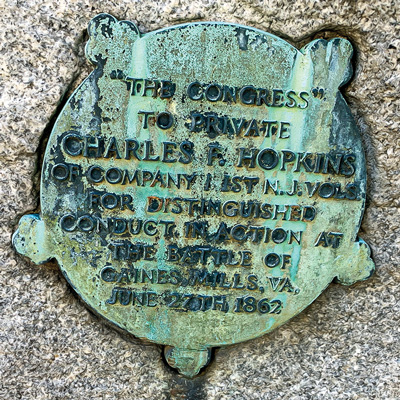
“Growing up in the 1960s, when Boonton celebrated its Centennial, there was a lot of interest in local history and Charles Hopkins was a local hero,” remembers Boonton native, Art Charlton. “To know that someone from our little town had earned the Medal of Honor for heroism, rescuing a comrade on the battlefield, and then later survived the notorious Andersonville, was an enormous source of pride. And then you have his efforts to help escaping slaves. Such derring-do! He truly seemed like the kind of guy who could be the protagonist in a movie. When researching my great-grandfather’s Civil War service years later, I learned that Hopkins had assisted my ancestor and others in obtaining the veterans’ benefits they were owed, and I gained new appreciation for the depth of his service to his comrades.”
Along with Charles Hopkins, among those left for dead at Gaines Mill was Major Henry Ryerson, of the 2nd NJ Volunteers. The son of a New Jersey supreme court justice, and a successful lawyer, Ryerson had helped recruit Company B from Sussex County. Ryerson, too, survived his wounds, was captured, then released to fight again as colonel of the 23rd and 10th regiments. Wounded twice more, he died in a Confederate hospital in 1864 and is buried in the Old Newton Cemetery. Named in his memory, today’s Col. Henry Ryerson Civil War Round Table is one of several groups that provide educational programs, lectures, and field trips for members.
Veterans of the nation’s epic struggle also receive vivid tribute in living history demonstrations in which infantry, artillery and cavalry reenactors form an integral part of commemorative activities throughout New Jersey. One of those, the 27th Regiment of NJ Volunteer Infantry Company F, was founded in 2001 by John Covert, the great-great-great grandson of the original company captain, Daniel Bailey. Covert, who grew up in Brookside (Mendham Twp. in Morris County) spent summers in the northern Sussex County village of Glenwood, where he learned about his family’s legacy during visits to the Glenwood Gristmill, General Store and Cemetery where Capt. Bailey was buried along with many other of Covert’s ancestors.
Born in 1841, Daniel was beginning an active life as a merchant and farmer on his family’s homestead when, in 1862, he was commissioned captain of Company F, one of eleven companies recruited for the 27th Regiment, largely from towns in Sussex and Morris counties, for a nine-month tour. After their training, 1,079 soldiers joined the Army of the Potomac and soon after took part in its catastrophic engagement at Fredericksburg in December, 1862. In 1863 the Regiment was detached for service in the war’s western theatre and on May 6 of that year met disaster while crossing the Cumberland River in Kentucky. Thirty-three men drowned when one of their boats capsized in rapid water. The Regiment was mustered out of service on July 2, 1863, the day that Robert McAllister received his wounds at Gettysburg.

Daniel Bailey continued his military career in Kentucky, eventually serving as a captain in the 123rd U.S. Colored Troops Infantry, and later on the staff of General James Sanks Brisbin. At the end of the war he returned to Glenwood to resume an enterprising career in the creamery business and extensive activities in community affairs. “After the war, Daniel became the first postmaster in Glenwood, plus owner of the general store, owner of the creamery , gristmill, and blacksmith shop,” explains Covert. “He paid to have the Glenwood Methodist Church built and was on the board of directors for the Glenwood Cemetery. He was responsible for bringing the railroad to Glenwood for his creamery. His hobby was the Sussex Battery, a GAR artillery reenactment group. He had two bronze cannons that were fired at events up until 1914. He was a charter member of the Sussex County Historical Society. My family passed down Daniel’s uniform and other possessions which I now have.”
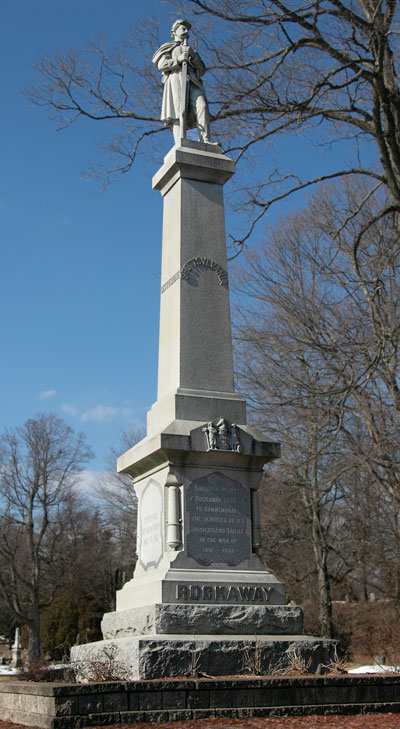
Along with about forty members, Covert serves the legacy of his ancestor and the honor of the volunteers of the 27th Regiment in a busy schedule of commemorations, educational demonstrations and reenactments. Each May there is a service at the Rockaway Presbyterian Church cemetery where nineteen of those who died at the Cumberland River disaster, a company recruited mostly from Rockaway Township, are memorialized. There are appearances scheduled at Memorial Day and Independence Day parades, Shippen Manor, Wharton Canal Day, Wild West City, Belvidere Victorian days, and Sussex History Day. And in October, Covert’s company of Bailey’s Boys returns to Glenwood for the annual skirmish and Civil War weekend at Pochuck Valley Farm. The group also specializes in programs for school groups and historical societies. The unit has accumulated a large collection of items from the 27th NJ and other units for display. Among those are a field hospital that brings to life the work of the United States Army Medical Department. Covert also maintains a website with historical documentation about the 27th Regiment along with details regarding the Company’s dedication to living history.
In 1815, the Presbyterian minister, Robert Finley, founded the American Colonization Society in Basking Ridge, institutionalizing the idea of repatriation as “the foundation for eventual emancipation in a legal manner… without violating the rights or injuring the feelings of our southern brethren.” The citizens of New Jersey remained largely ambivalent about the emancipation of slaves and often sympathetic with the secessionists, despite a vigorous abolitionist network that conducted the Underground Railroad network through the state. Nevertheless, almost 58,000 New Jersey men served in the Civil War. With reenlistments, the state would eventually receive credit for more than 80,000 terms of service. Seek out their stories of triumph and tragedy.
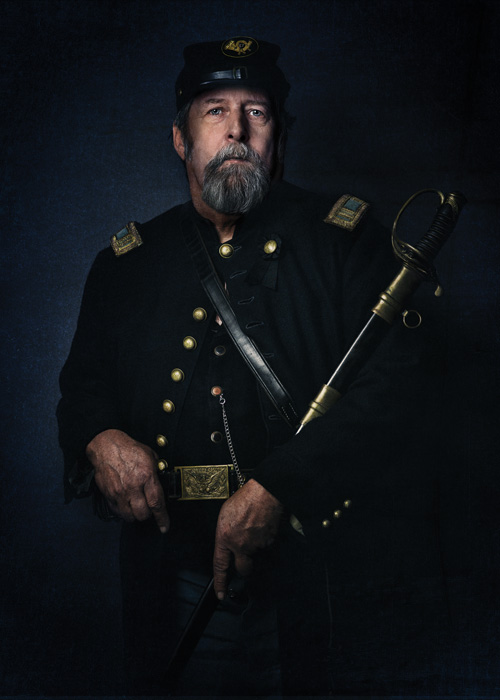
Morristown in the Civil War...